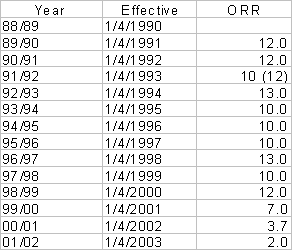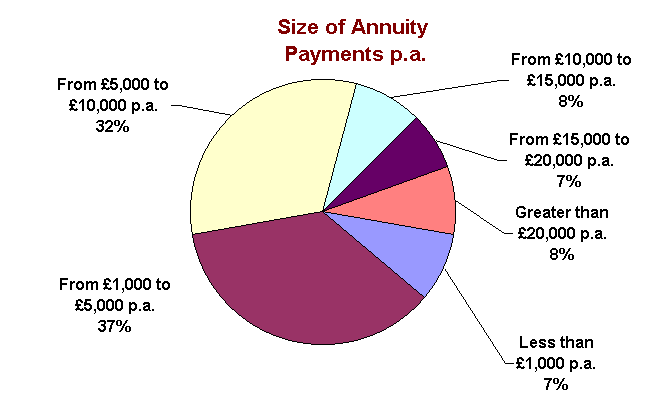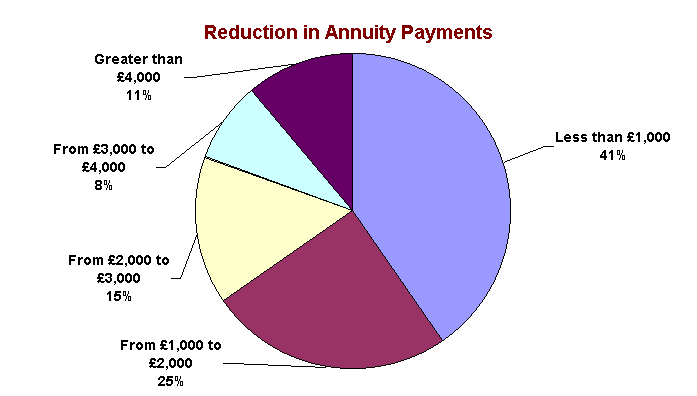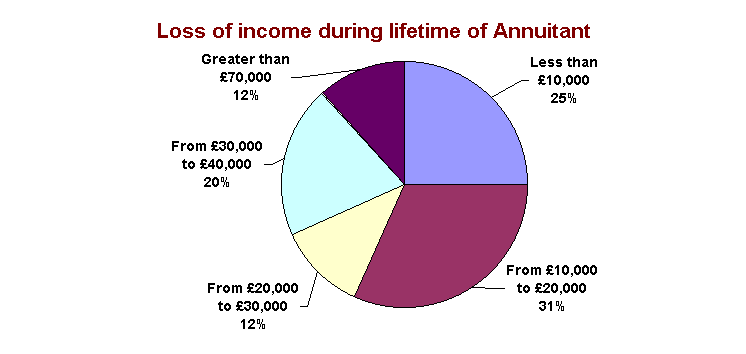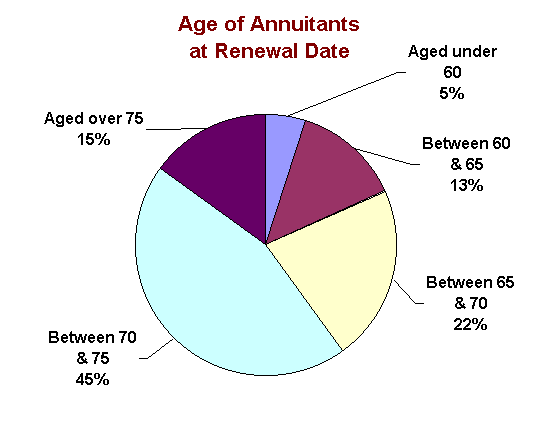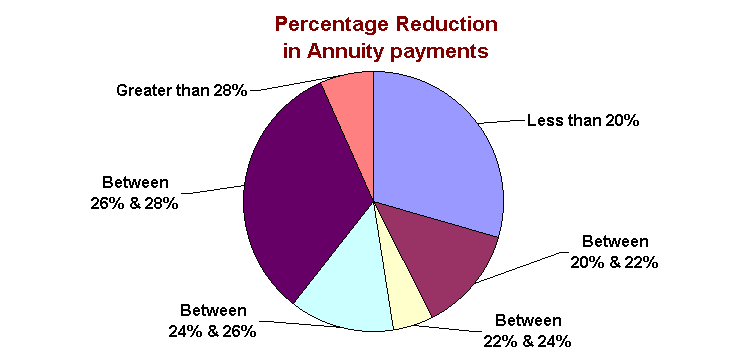|
|||||||||||||||||||||
Equitable Life Assurance Society And Its Handling of With-Profits Annuities |
|||||||||||||||||||||
|
SECTION 2 The
Impact of the so called “20% and other Reductions” on Annuitants 2.1) Introduction This analysis started
as an attempt to understand and explain to other With-Profits Annuitants (WPAs)
the impact of the so-called “20% reduction” in annuities that came into
effect from March 1st 2003. That it was not 20% and whether it was
applied equitably as explained by the Society was one of the primary drivers in
the preparation of this report. In the course of the analysis, it became clear
that there were other deeper, subtler, and more complex issues that needed
exploration and understanding. This section, one of three, is intended to be
self-contained, but where possible should be read in conjunction with the other
two. 2.2) The Equitable Life
Annuity
Regrettably in order to
understand what follows, it is necessary to explain how the annuity system of
the Society works. There is a more detailed analysis in Section 4 but the
following is intended to be enough for this section The Equitable Life
Assurance Society (ELAS) produces With-Profits Annuity - Annual Statements every
year for each annuitant and which in general contain the following information: The
Renewal Date Basic
Guaranteed Annuity (BGA) Declared
Bonus Annuity (DBA) Final
Bonus Annuity (FBA) Total
Gross Annuity (TGA) Historically, the
Society also produced another document and somewhat confusingly called the Bonus
Declaration for the Year Ending 31 December 19NN, which contained references,
amongst other things, to: Anticipated
Bonus Rate (ABR) Overall
Rate of Return (ORR) Declared
Bonus Rate (DBR) There is one other
abbreviation that must be introduced which is: The
Total Return for a Level Annuity (TRL) N.B. In the footnote to
each page is a summary of all the abbreviations used in each section as an aid
to understanding. Until
July 1996, With-Profits Annuities contained a Guaranteed Interest Rate (GIR) of
normally 3.5% per annum, which was to be allotted BEFORE any policy bonus. The
GIR is NOT a bonus. It is a contractual entitlement similar in principle to the
former GAR. All With-Profits annuities since mid-1996 are non-GIR. For GIR annuities the
TRL is the ABR x 1.035 and for non-GIR annuities the TRL is the same as the ABR. At the outset of an
annuity, the annuitant transfers a sum of money, the consideration, in
exchange for a regular payment, the annuity. The annuitant agrees with
the Society in advance an anticipated rate of return (ABR). Very
simply the annuity is calculated using a combination of the various interest
rates, ABR, ORR, etc from the initial annuity value which is determined by the
amount of consideration money and the rates for conventional annuities relevant
to the policyholder. Each year the Society computes new values for each
element of the annuity using two separate arithmetic series by using the ABR,
TRL, DBR & ORR in different ways, so that the series in theory diverge. i) One series computes the BGA and DBA ii) The other series computes the TGA. The
BGA and DBA are “guaranteed” under the terms of the annuity, which is not
quite what it seems, not least because these two elements of a With-Profits
Annuity do not give a constant annual guarantee. The BGA is a reducing
guarantee, which is at the rate of the ABR, whereas the DBA can increase,
remain level or increase depending on the relationship between the ABR chosen by
the annuitant and the DBR for each year set by the Society. The
Total Gross Annuity (TGA) is increased each year by the effect of the ORR and
decreased each year by the effect of the TRL. Thus if the ORR is greater than
the TRL then the annuity will increase and if the ORR is less than the TRL then
the annuity will decrease. The
FBA is the difference between the TGA and the sum of the BGA and DBA. However,
the FBA is not guaranteed at all and can be withdrawn by the Society at any
time. In
discussions with many WPAs, it is clear that they recognised that the Total
Gross Annuity (TGA) might go down in ‘bad years’ and then it would recover
in ‘good years’ and that the Society would do its best to even out these
variations to provide a constant level of income. However, when the decision to
make the 20% reduction was implemented, it was immediately clear for the very
first time, not only how the FBA was derived, but that it was added at the
discretion of the Society and, much more importantly, it could be removed in its
entirety by the Society, also at its discretion with a devastating consequence
on the TGA and the incomes and lifestyles of the With-Profits Annuitants. 2.3)
The “20% Reduction” In
November 2002, the Equitable Life Assurance Society (ELAS) announced that it had
to reduce the annuities of one class of its annuitants, the so-called
With-Profits Annuitants (WPAs), who had not until
then suffered any serious reduction as a result of the problems that beset the Society. The full text
is attached to the end of Section 4. The following is an extract: “Following
the House of Lords' decision in July 2000, we had to reduce the value of
with-profits policies. We did this,
other than for with-profits annuities, by reducing the policy value by 5% at
that time. We made significant
further reductions in July 2001, April 2002 and July 2002. This means, allowing for bonuses, our other with-profits
policyholders have suffered an overall reduction of about 20%. So far we have
largely protected you from these falls. In
fact, you and other with-profits annuitants have generally received a positive
investment return of about 14% over the same period. As
we have said, most other with-profits policyholders have suffered significant
reductions in the value of their policies, whereas those who have with-profits
annuities have not. We were able to
do this because if you have a with-profits annuity, you cannot withdraw your
funds. It was possible for us to
phase the cuts to with-profits annuities in the hope of improved financial
conditions. Unfortunately, because
conditions have not improved we can no longer keep doing this. This
basically means that with-profits annuities, like yours, are now out of line by
about 30%. Action we need to take now
We
now need to bring with-profits annuities back into line with other policyholders
and we plan to do this over two years.
We will be putting in place the following changes. ·
On your policy
anniversary after 1 February 2003, we will reduce the value of your total
annuity, which we would otherwise pay, by up to 20%.
This action replaces the current approach of reducing the overall rate of
return over the term of the policy.
We will then reduce your income payment again in 2004 to regain any over
payment, which may still apply.” With this document was one of a regular series from the Society entitled “How your With-Profits Annuity works”. The relevant page of this document, also attached at the end of Section 4, included a table explaining the probable range of the reduction. The table and the headline “No more than 20%” appeared to be in contradiction with each other, though as set out below, the significance is now clear. Both of these documents contain assertions, which are arguably either incorrect or confusing, not least ‘that it was not possible to be precise about the amount of money to be removed’. The calculation is trivial even by hand and with the IT resources available to the Society, there is no reason why the precise amount could not have been announced for each annuitant in the November 2002 communication from the Society. In addition the
statement that “we will reduce the value of your total annuity, which we
would otherwise pay, by up to 20%”could have been better expressed as “The
FBA will not be reduced in this fiscal year by more than 20%, but in addition to
this reduction, your total annuity, TGA by this definition, will be reduced as
consequence of reductions to the BGA and DBA”. Further the assertion
that the WPAs have ‘generally received a positive investment return of
about 14% over the same period.’ may mean something to the Society and one
can be sure it is accurate but in reality, the annuitants in the same period
have generally seen a reduction in their income from the Society. That
is what counts to annuitants. 2.4) The “Other Reductions”
In the period between
2000 and 2003 the Society had made a number of changes that affected the income
of the WPAs. These were: 1)
The so-called “20% reduction” in annuities as described above. 2) A reduction of 1% in the published Overall Rate of Return (ORR) in 2000 & 2001 and a further reduction of 1.5% in 2002 and 2003 following the ruling from the House of Lords. 3) The Society reduced
the ORR from its previous levels, which historically had been set at |
|||||||||||||||||||||
|
As can be seen, in 2001
and 2002 the Society substantially reduced the ORR from its historical level. 4)
In parallel to this action the Declared Bonus Rate has also been reduced as
follows:
The significance of the reduction in the DBR is NOT that it reduced the Total Gross Annuity since that is controlled by the relationship between the ORR and TRL but that it transfers more of the annuity from the guaranteed protected element of the annuity, the DBA and into the un-guaranteed, unprotected FBA. This is very significant. There have been four
reductions each of which has a cumulative effect: 1.
The imposition of a 20% reduction in the annuity. 2.
The imposition of a 5% reduction in the ORR, but spread over 4 years. 3.
The decline from the ‘historic average’ ORR of approximately 10% to a
much lower level. 4.
The reduction of the Declared Bonus Rate (DBR) to zero since 2000. There are so many
variations and possible combinations in ways that the impact of these reductions
can be assessed, that it would only serve to confuse the point to illustrate
them all but: a)
If the ORR had maintained a level of 10%, then my annuity, for example,
would be approximately 4% higher than it is today. b)
If the 5% reduction had NOT been imposed & the ORR had
maintained a level of 10%, then my annuity, for example, would have been
approximately 15% higher than it is today. c)
If no reductions had been imposed, then my annuity, for example, would
have been approximately 42% higher than it is today. No attempt has been
made to make parallel comparisons for other annuitants but taking a 15%
reduction in my annuity payments as a benchmark (and making adjustments for life
expectancy and relative size of my annuity to the average), that is equivalent
to taking approximately £600 million from the annuitants over the
remaining lifetime of the policy. As mentioned above, the
headline “No more than 20%” has caused widespread misunderstanding as it was
not clear that this only applies to the FBA and that the normal reductions that
apply to everyone’s annuity were in addition. The other ‘normal
reductions’ are as follows: 1.
BGA is reduced each year by your chosen ABR. If the BGA last year was £7,629
and the ABR was 7.0%, then this year’s BGA will be 7,629 / 1.07 or £7,130 2.
The DBA is reduced in a slightly more complex manner since it is a
function of both the ABR and DBR. However, for the last 3 years the DBR has been
set to zero by the Society, so in effect the DBA is reduced in the same way as
the BGA. If last year’s DBA was £1,817, then this year’s DBA will be 1817 /
1.07 or £1,698. So in other words, even
before the Society has started on the “20% reduction”, the annuity in this
example has reduced by £618 or to 94.3% of last year’s value. (That is 1.00 /
1.06 = 0.9434) Next
the reduction is only and can only be applied under the terms of the
With-Profits Annuity to the FBA. The Society has advised that the calculation is
as follows: 1.
Take 20% of last year’s TGA. 2.
If this number is less than this year’s FBA, then reduce this year’s
FBA by that amount and leave the balance as the new FBA. 3.
If this number is greater than this year’s FBA, then reduce this
year’s FBA to zero. In which case this year’s TGA becomes the sum of this
year’s GBA and DBA. That
may look complicated but the very real consequence is that some annuitants, who
had a large FBA received a very high reduction. In the above example, the
reduction is approximately 27%. Other annuitants with a relatively small FBA,
suffered a much lower reduction, in some cases as low as 13%! This
neither looks or feels fair, but it is an inevitable consequence of the ABR
chosen by the annuitant under quite different conditions and for quite different
reasons many years previously. This
skirts the serious question whether WPA’s who chose a high ABR, in effect
their TRL, understood the implication that a higher percentage of their annuity
would be un-guaranteed and unprotected. This is difficult enough for the non-GIR
annuitants but for the GIR annuitants, their situation was even worse as their
effective TRL was their ABR multiplied by the 1.035% guaranteed interest rate! The
‘guarantee’ unquestionably increased the starting level of the annuity for
GIRs but exposed them to a much higher risk in the event of a reduction in rates
of return and more exposed as a greater percentage of their Total Gross Annuity
(TGA) was un-guaranteed. However, what must NOT be over-looked is that in the years preceding the “20% reduction”, which can ONLY be applied to the FBA element, the Society had massively increased the amount of money in the FBA element by reducing the DBR to zero. Whatever, the reason or justification for that action, the amount of money that could be removed by the Society had been significantly increased since 2000. On the basis that there
are approximately 65,000 WPA’s and that the weighted average reduction in
annuity is approximately £31,000 per annuitant, the Society has removed
approximately £1.5 billion from the pockets of its annuitants that it
was otherwise committed to paying over the lifetime of the annuities. In communication with
one annuitant the Society responded and with his permission the following
extract is included: “Following my father-in-law's death, we wrote to ELAS and received a reply from which I quote: "The planned reduction under your policy is between 22% and 28%, 20% of the reduction will be taken on the anniversary of 28 June 2003 and the remainder (between 2% and 8%) will be taken on 28 June 2004. The reduction will apply to each benefit." In this particular
annuitant’s situation the FBA is zero for all three annuities, so it is not
legally possible for the Society to reduce the annuity further, so what the
Society intended to say or what the Society understood by its own letter is not
clear. But what it implies is that for all those annuitants who have some
residual FBA the Society also plans to reduce that to zero. This means that with
this action the Society will remove a further £350 million. In total it appears
that the Society plans to remove every element of the WPAs income that it can
argue to be permissible under the terms of the annuity, irrespective of the
financial needs of the Society or the exigencies imposed on the persons least
able to protect themselves and their financial interests. Just on the actions
announced by the Society so far this adds up to approximately £2.5 billion
– an astonishing amount of money transferred from people’s investments for
their old age by a Mutual Society set up to protect their interests. Whilst some may have
other income and annuities with other Life and Pension companies, looking at the
actual incomes of the WPAs prior to the reductions, it cannot be said that they
are wealthy or even comfortably off and that any reduction in their income
represents a major loss of lifestyle, plus fewer essential things purchased or
the ability to purchase services, such as a cleaner or a gardener, when age
related infirmity precludes such activity. After a lifetime of saving and
investment, these annuitants have
Policy Holders Reasonable Expectations (PREs) as set out in the insurance
legislation that they should
be free of money worries from policy reductions imposed by the Society. (See
Chart 1) It
has been stated that it is possible that many annuitants have other sources of
income but surely nobody is arguing that it is acceptable to reduce someone’s
income just because they have other sources. In any event, people develop a
lifestyle to meet their income. Pensioners in general are careful to manage
their affairs carefully as they are only too aware that even low inflation
gradually erodes their income, which in normal situations is fixed for their
remaining lifetime. The whole objective and attraction of With-Profits Annuities
was to provide some protection against the corrosive effect of inflation on
people with fixed incomes. In other words, the WPAs will have budgeted to modify
their homes for old age, or set aside reserves if they need to go into a
Retirement Home or into a Care Home. Thus any reduction is a very real loss even
if it may seem to be quite small. It must also be
emphasised that there is a big difference between income and discretionary
income. A reduction of say £3,000 p.a. from an income of say £30,000 p.a. may
not appear so bad. However, the majority of the income may be committed is
non-discretionary to pay Income Tax, Community Charges, Utilities, Insurance,
Hire Purchase, Rent or Mortgages, bills that have to be paid come what may. The
rest of the income can be defined as discretionary for items one can choose to
buy or not, though note that by this definition, discretionary income includes
food! An annuitant’s discretionary income may be as low as 30 to 35% of the
total income, or say £10,000. A loss of £3,000 p.a. in this situation has a
very much larger impact and will require a significant and difficult change in
lifestyle and plans. (See Chart 2) Based on the data
received from the annuitants, the overall loss of income over the remaining
lifetime of the annuitants or the amount of money transferred from the pockets
of the annuitants to the funds of the Society is approximately £2.5 billion
pounds. Even allowing for statistical uncertainties this is an enormous transfer
of wealth, made without discussion or with any form of justification and from
people who are least able to make up the difference with future earnings. (See
Chart 3) These annuitants who
are suffering these major reductions in income are at an age when they can do
little to make alternative arrangements to boost their income and thus have
limited, if any, opportunity of recovering these losses through paid work. (See
Chart 4) 2.5)
Summary
The Society appears to have taken substantial sums of money from the present and future income of its WPAs who legally cannot transfer their annuities to another life company or make any other changes and are completely at the whim of whatever the Society decides it is able to do at its own discretion and under the terms of polices that were never intended to cover this type of contingency. There have been or will be three reductions: 1)
The initial reductions made as a result of the House of Lords ruling and the
lowering of the ORR are costing the WPAs approximately £600 million over
the life-time of the annuitants, transferred from their accounts into the funds
of the Society. 2)
The Society did not mention and did not make clear that the 20% reduction was in
addition to the normal reduction the annuitant has agreed each year as a result
of the bonus rate that was chosen by him or her at the start of the annuity.
Thus if you have a 7% bonus rate, then the reduction had to be close to 27%! What
is also less clear but implicit in this method of calculation was that those
annuitants whose Final Bonus Annuity was large, had a larger reduction than
those annuitants whose Final Bonus Annuity was relatively small. This is neither
just, nor fair nor equitable There
is no correlation between the age and size of the annuity and only a limited
correlation on the bonus rate chosen at the start of the annuity that was more
often than not strongly influenced by
the Society’s sales force. On
the basis that there are approximately 65,000 WPA’s and that the weighted
average reduction in annuity is approximately £31,000 per annuitant, the
Society has removed approximately £1.5 billion from the pockets of its
annuitants that it was otherwise committed to paying over the lifetime of the
annuities presumably to fund its other liabilities. 3)
It is clear from the letter written to an annuitant that next year the Society
it intends to remove any remaining FBA even though the inequality of reduction
between annuitants will be even larger at the end of this process. This will
result in a further transfer of approximately £350 million from the
annuitants. The
total transfer is an astonishing sum of money and one that deserves a detailed
explanation from the directors, and the regulatory bodies involved, one that so
far has not been forthcoming. Finally,
the Society states that we must all suffer equally, which is at least
questionable even within the group of clients called the With-Profits
Annuitants, WPAs. But
the fact is that the WPAs are NOT equal to other groups of the
Society’s clients. 1.
They are not protected from further losses. 2.
They cannot recover these losses by seeking employment, even if age and
infirmity do not preclude such an activity, since employment for people of
pensionable age is not easily found. 3.
They cannot transfer their funds to another life office in order to
obtain greater stability and certainty of income. 4.
The reductions can never be recovered no matter how well the With-Profits
Fund performs in the future as the WPAs capital has been partially wiped out by
the actions or inactions of the Society. It
is a superficially appealing argument that, though convenient and easy for the
Society to enunciate, is in fact without ethical or logical merit at all. The following charts are based on data extracted from information supplied by the annuitants and summarised. The vast majority of the annuitants have supplied their policy numbers, so that if necessary, the data can be confirmed by third parties, though that will only be done with the express consent of the individuals involved.
|

